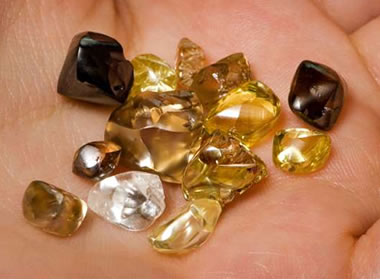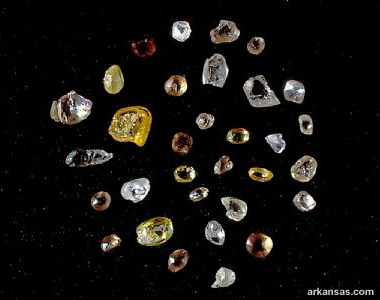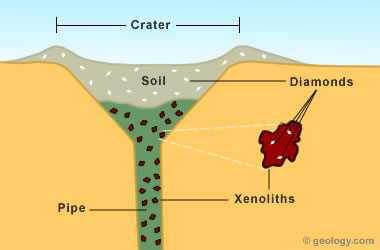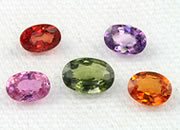Home » Minerals » Diamond » United States Diamond Mine
The Only Diamond Mine In the World Where You Can Be the Miner
The Arkansas Diamond Mine at Crater of Diamonds State Park
Article by: Hobart M. King, PhD

Diamonds Found at the Mine: This small handful of diamonds was found at Crater of Diamonds State Park. Yellow, brown and "white" diamonds are all found regularly at the park. Many have a rounded octahedral or a rounded dodecahedral crystal habit. Image courtesy of Arkansas.com.
Where Can You Find Diamonds?
If you have a strong interest in gemstones, you would probably love to have an opportunity to mine for diamonds yourself. Here's where you can go - it is the only producing diamond mine in the United States and the only diamond mine in the world where you can be the miner.
Crater of Diamonds State Park
This diamond mine is located near Murfreesboro, Arkansas. For a fee of a few dollars you can enter the mine, search all day and keep any diamonds that you find. In addition to diamonds, you might find one of the many colorful gemstones that occur naturally there. These include: amethyst, agate, jasper, garnet, peridot, hematite and many others.
The diamonds at the Park occur in the soil, and that makes them easy to look for. Some people find them after it rains by walking through the field looking for the bright reflection of a diamond that has been washed clean by the rain. Other people dig in the soil and carefully search through it one shovel-full at a time. You can bring your own tools or rent tools at the Park. Power tools are not allowed; however, the Park periodically plows the diamond field to turn up fresh soil.
Searching is easy but you will need a combination of luck, patience and a very sharp eye to find a diamond. Most people don't find a diamond during their visit, but a few miners have been extremely successful. Everyone has fun.
Crater of Diamonds video: This video shows how a few visitors at Crater of Diamonds State Park look for diamonds. One of the visitors interviewed is Denis Tyrell, who found the 4.42 carat "Kimberly Diamond" at the Park in 2008.
Who Discovered Crater of Diamonds?
Diamonds were first discovered at this location in 1906 when John Huddlestone found two strange crystals in the soil of his farm. He didn't realize that his farm was right above a volcanic pipe filled with lamproite (a volcanic rock formed from partially melted mantle materials which sometimes contains diamond-bearing rocks known as xenoliths that have been transported up from the mantle).
Huddlestone suspected that his crystals might be diamonds and took them to a local jeweler for assessment. Word of the discovery leaked out and a "diamond rush" began. Soon thousands of people descended upon the Murfreesboro area; however, the Huddlestone farm and immediately adjacent land was the only location with promise of becoming a diamond mine. Why? Because the diamond-bearing pipe was several hundred yards in diameter. There are other volcanic pipes in the area, but they have yet to yield more than a few diamonds.

Arkansas diamonds: All of these diamonds were found at the Crater of Diamonds. Most of the diamonds found at the Park are in a color range from white to yellow through brown. Image courtesy of Arkansas.com.
Inspiration from Africa
The big diamond rushes in Africa occurred in the late 1800s, and information about the deposits there was widely published. Prior to Huddlestone's discovery, geologists at the Arkansas State Geological Survey suspected that diamonds might occur in the greenish peridotite soils near Murfreesboro because they were similar to the soils above the African diamond deposits. They did fieldwork in the area but did not find any diamonds.
The general public also knew about the diamond rushes in Africa, and this fueled excitement about Huddlestone's discovery. One of the large diamond discoveries in Africa was also made on a family farm. The owners of the farm sold out because they could not protect their land from the hordes of diamond hunters. The farmers' name continues today as the name for one of the largest diamond mining companies in the world - De Beers.
John Huddlestone sold his farm for $36,000 and it was later bought and sold multiple times. It was temporarily worked as a commercial diamond mine. It was not extremely productive and was not reopened after a fire destroyed the plant in 1919. Properties adjacent to the Huddlestone farm were also heavily prospected with some attempts at diamond production, none of which were sustained.

Strawn-Wagner Diamond: Photograph of the famous "Strawn-Wagner Diamond" found at the Park in 1990 by Shirley Strawn. It was the first stone to receive a perfect grade of 0/0/0 from the American Gem Society. Image courtesy of Crater of Diamonds State Park.
Wet Sifting for Diamonds: This video shows how to sift soil through a series of screens to search for diamonds. This is how some visitors find diamonds at Crater of Diamonds State Park.
Pay-to-Prospect Mining
In the early 1950s the property was opened as a public pay-to-prospect mine, and in 1951 the name was changed to the "Crater of Diamonds." The State of Arkansas purchased the property in 1972 and began operating it as "Crater of Diamonds State Park." It is still open year-round as a pay-to-prospect mine visited by over 100,000 people per year.
Most visitors do not find a diamond, but almost everyone has fun prospecting. Since the park opened in 1972, a little less than 3,000,000 paid visits to the park ("visits" is used instead of "visitors" because many people visit the Park many times) have resulted in about 30,000 reported diamond finds. Most of the diamonds found are very small - too small for cutting into a mountable stone. The 30,000 stones reported have an aggregate weight of a little under 6,000 carats, making the average stone about twenty points (.20 carat) in weight.
The diamonds and other minerals found at Crater of Diamonds State Park are genuine Arkansas minerals. They are not "salted" specimens brought in from other localities to enrich the soil or the collecting experience. Diamonds from the Park have unique characteristics, and experienced individuals are able to recognize them.

Lamproite pipe: Simplified cross-section of a lamproite pipe and residual soil deposit. The "Crater of Diamonds" is part of a volcanic feature that is known as a "maar."
Spectacular Diamonds Found At The Park
Although most stones found are small, some spectacular specimens have been found.
The "Uncle Sam Diamond," the largest diamond ever found in North America, was found there in 1924. This pale brown, 40.23 carat stone was found in 1924 by W. O. Bassum. It was cut into an emerald-cut gem weighing 12.42 carats which was sold in 1971 for $150,000.
The "Strawn-Wagner Diamond" was found in 1990 by Shirley Strawn. This 3.09 carat stone was cut into a 1.09 carat brilliant-cut gem. It was the first stone to receive a perfect grade of 0/0/0 by the American Gem Society. A photo of the diamond can be seen on this page.
A number of beautiful colored diamonds have been found at the Park. The most famous is the "Okie Dokie Diamond" found in 2006 by Marvin Culver. This 4.21-carat canary-colored diamond was featured in a number of television programs and magazine articles. Yellow and brown diamonds of gem quality are regularly found at the mine.
Some Not-So-Spectacular "Finds"
The Crater of Diamonds is the only producing diamond mine in the United States, and many people who collect minerals or gemstones would like to own a genuine United States diamond. This patronage of the locality gives a small diamond found at the Park a value that is much higher than a diamond of similar size and grade found at almost any other location in the world.
In 2007 a person reportedly purchased a number of diamonds from a mine in India that were similar in characteristics and color to diamonds found at the Park. This person then visited the Park and claimed to "find" these diamonds in the soil of the Park. His intent was to sell them on eBay as "United States diamonds." Fortunately, a small group of mineral experts became suspicious of the "finds" and documented it as a fraud.
| Sources of More Information |
|
Crater of Diamonds State Park - Visit the official website for more information about the diamond mine, park hours, fees, driving directions and more.
Mindat.org - Photos of several of the more impressive diamonds found at Crater of Diamonds State Park. The Curious Case of the Arkansas Diamonds by Brendan Borrell. Includes a photo of the 4.42-carat "Kimberly Diamond" found by Denis Tyrell in 2008. Smithsonian Magazine Website, January 9, 2009. Last accessed May 2022. Arkansas Geological Survey - Geology of the Crater of Diamonds State Park and Vicinity, Pike County, Arkansas. State Park Series Report 03 by J. M. Howard and W. D. Hanson, 2008. |
Why Are Diamonds Found in Arkansas?
The occurrence of diamonds in Arkansas continues to intrigue geologists. About 100 million years ago a deep-source volcanic eruption occurred in this area, bringing material from the mantle rapidly up to the surface. The rising magma was rich in gases that expanded to thousands of times the volume that they occupied while under the enormous pressures at mantle depth. This rapid gas expansion produced an explosion as the magma approached the Earth's surface. This explosion blasted a crater and blanketed the surrounding landscape with ejecta.
Within the ejecta were many fragments of mantle rock that were carried up to the surface with the rising magma. These fragments are known as "xenoliths." They contained the diamonds.
Over time the ejecta was weathered, and a greenish soil formed above the crater. During the weathering process the least stable minerals were destroyed and the most stable minerals were concentrated in the soil. Diamonds are very resistant to weathering and were thus concentrated in the soil.
| More Gemstones |
 |
Tourmaline |
 |
Fancy Sapphires |
 |
Diamond |
 |
Canadian Diamond Mines |
 |
Birthstones |
 |
Pictures of Opal |
 |
Fire Agate |
 |
Blue Gemstones |

Find Other Topics on Geology.com:

|

| ||

|

| ||

|

| ||

|

|
